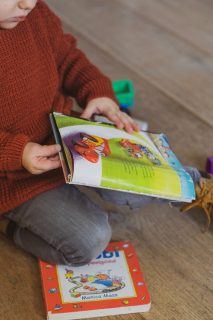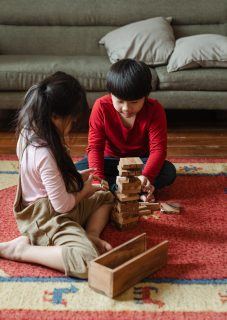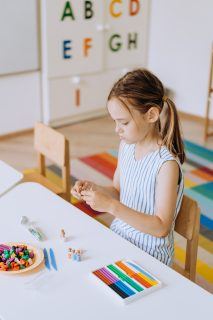Children rapidly develop motor skills, like climbing and running, in their early childhood years (from birth to age five). However, cognitive development is based only on pre-operational thinking, meaning these children rely on what they can see primarily.
Thus, kids in need of counseling and therapy require various psychological, cognitive, emotional, and developmental techniques appropriate to their age and abilities.
Play is vital in the social development of kids in their early childhood. They learn new words and phrases to express themselves and how they feel. During play, children can say how they feel and share their perspectives. Because of this, counselors use the play method in most of their therapy sessions with children.
Therapists create a safe, comfortable, and creative environment for play therapy. This space is filled with toys meant to develop healthy behavior and encourage self-expression. During these sessions, the counselor may be present. Or, they can leave the children to play while observing them using a security camera installed in the playroom.
Here are some counseling methods used in children’s counseling.
Counseling Methods For Children With Attachment Issues and Trauma
Storytelling Time

Photo by Sven Brandsma on Unsplash
This process allows kids to tell a story they want to narrate or something that happened in their life. Storytelling helps kids present solutions to their problems. Usually, a counselor would read a story with an issue and engage the kid in a dialogue. As all of this happens, the counselor records observational data on the child’s responses, emotions, and feelings towards the story’s resolution.
Playing With Puppets
This activity is a form of dramatic play that encourages children to express their feelings and recount stories before negative events.
Using puppets is said to be effective when a parent or caregiver actively participates. Larger animal-shaped puppets are often used with kids ages three to four. Meanwhile, smaller and isomorphic puppets are used with toddlers and infants.
Playing With Dollhouses

Photo by Ketut Subiyanto from Pexels
In therapy, kids may use a dollhouse to explain what happens at home, from the perspective of the child. This method helps children access memories of their household. Counselors can choose between directives or non-directive playtime.
In directive dollhouse plays, the counselor asks or prompts the child to tell them what happens in the house’s different rooms. On the other hand, non-directive dollhouse play allows the child to freely play with the items in the dollhouse as the counselor makes observations and notes.
Drawing
Drawing gives children an opportunity to express themselves creatively and how they feel about their experiences. This activity aims to promote connection, comfort, and fun for kids.
How well a child draws is based on their abilities and developmental levels. They will be handed paper and creative materials, such as pens, crayons, paint, or markers.
Use Play Dough or Clay

Photo by Mikhail Nilov from Pexels
Playing with clay allows children to create representations of their families and other people. It is a type of kinesthetic play that uses a moldable medium, allowing kids to express their feelings and contextualize sensory experiences.
This type of play involves counselors telling kids to mold on clay the essential people in their lives and try to connect emotions to these representations.
Play With Feeling Faces
These feeling faces are representations of the different human emotions. They can be printed or digitalized. Counselors use these faces to allow children to identify their facial expressions and emotions.
During this type of play, counselors direct the child to pick facial expressions the child is drawn to. Their face options range from a sad, crying face to a happy, smiling face. After the child chooses, counselors then identify themes and associations between the facial expressions and the problem.
Playing With Popsicle Sticks
This play encourages children and their parents or caregivers to bond by making popsicle stick figures. The counselor mediates between the child and the parent or caregiver as they create these figures with other crafts and creative materials and allows them to tell their story. This activity may be done at home, in between therapy sessions.
Types of Insecure Attachments
There are three categories of insecure attachment styles, including resistant, avoidant, and disorganized-disoriented attachment.
Resistant Attachment
This attachment style is linked with parents or caregivers who avoid their children’s distress and wait for the children to get upset before soothing their kids. Children with a resistant attachment type maximize their distress and under regulate their emotions. They interact with people through their grief.
These kids get frustrated easily and see experiences as threatening. They may grow up with underdeveloped self-confidence and live with anxiety or helplessness.
Disorganized-Disoriented
This attachment type is associated with caregivers or parents who are frightened, helpless, disengaged, or confrontational. These caregivers passively put their children’s welfare at risk due to the lack of involvement or preventive skills. Children with a disorganized-disoriented attachment type are observed to have hostility, freezing responses, and constant confusion.
Avoidant

Photo by Eren Li from Pexels
Avoidant attachment type is seen in children with emotionally unavailable caregivers who assign child care to other people.
Children with this attachment style may exhibit indifference towards the presence of the primary caregiver or parents and display detached responsiveness to others. This detachment limits their interaction with others.





![women [longevity live]](https://longevitylive.com/wp-content/uploads/2020/01/photo-of-women-walking-down-the-street-1116984-100x100.jpg)









